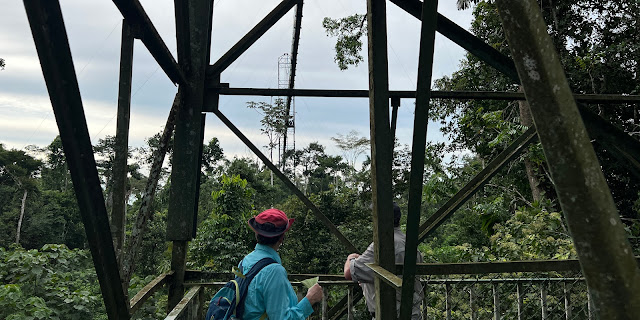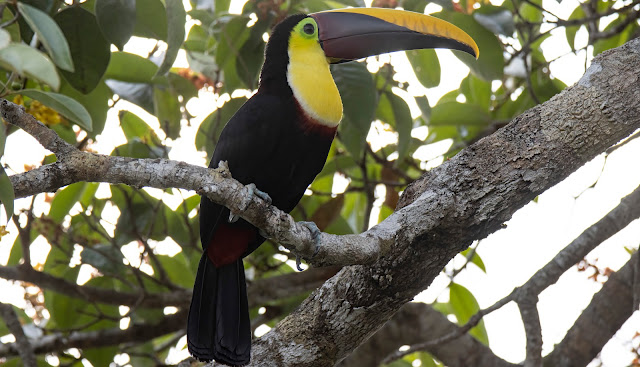 |
| White-throated Toucan from the Canopy Tower |
I was glad to be heading for the Canopy Towers sooner rather than later, but was concerned that it might start to get dark, which would be tricky for photos. It turned out, for the most part, the fear was unfounded.
 |
| Our destination; Right photo; Sacha Lodge |
The trail to the Towers is about a mile or so, through the jungle, including some muddy spots. It was, however, a pretty easy walk. We didn’t see anything on the way except for one stop where we had to scrunch under an overhanging tree to see two napping Crested Owls.
 |
| It was dark, so I was pleased with the photos I got, even though they’re not great |
I had seen a Crested Owl in Costa Rica, as well.
 |
| This one in Costa Rica was at night, but our guide illuminated it with a flashlight |
After a couple of minutes watching the Owls, one which slept and one which eyed us suspiciously, we continued on to the Towers.
 |
| Exciting, but sad! |
Also along the trail is a sign that put an arrow through my heart, although I already knew it was there.
The Sacha Lodge recently discovered a Harpy Eagle nest on their property. Now, the Harpy is one of the absolutely coolest birds on Earth and, having heard that there had been sightings at Sacha, I was so hoping to see one. But, the nest is protected and you are not allowed to go near it. That makes sense, but still …
The Sacha Lodge has a webcam on the nest, so you can watch from the ramada.
 |
| Harpy Eagle: Left photo: Del Amazonas; Right: Sacha Lodge Harpy webcam |
When we got to the Canopy Towers, the sun came out and the humidity tweaked up a bit.
The climb up was tough, but the experience was great.
 |
| Part of the way up |
 |
| Looking down the stairs |
The Canopy Walk is not quite as high as the Kapok Tower that we had visited that morning, but certainly more impressive.
The structure comprises three separate towers, each about 94 feet above the jungle floor.
They are connected by two suspension bridges that total 940 feet long.
I am not really afraid of heights, but the walk across is just a tiny bit unnerving.
If you are afraid of heights, you might want to skip this.
 |
| Straight down |
Even though the bridges have high sides, the swaying as you walk makes you want to walk quickly, but walking quickly increases the sway.
You might also want to not look to close at fraying wires and rusting bolts.
The view was pretty darn spectacular.
 |
| Vista; Photo: Scott Stevens |
The jungle below is beautiful.
We saw a fair amount of birds, most of which were (as before) pretty far away. Still, there was a lot of variety.
I had a couple of repeats from the Kapok Tower …
 |
| A male Flame-crested Tanager and a Golden-bellied Euphonia (this one a male) |
The Euphonia was one of four birds sitting close together on some exposed branches.
 |
| Four birds; three species |
The other three were a male Orange-bellied Euphonia and two White-browed Purpletufts (yes, that is the real name) …
 |
| Male Orange-bellied Euphonia flanked by male and female White-throated Purpletufts |
That was a nice display of tropical birds.
There were a couple more Tanagers, including that Palm Tanager I showed above and a couple of beautiful iridescent Masked Tanagers …
 |
| One of the prettiest birds we saw |
Fortunately the Tanagers got a little closer than some of the other birds. This Chestnut-fronted Macaw was almost invisible!
We saw a pretty bird on a wire near the platform that I immediately recognized as a Tityra, thinking it was a masked Tityra, the same species I had seen in Costa Rica.
 |
| I thought I was seeing this |
But, when I got home, I discovered it was actually a Black-tailed Tityra. A Lifer! We saw several, including the male ...
 |
| But, this one has a fully black tail, hence Black-tailed Tityra |
… and a female …
 |
| The female is streaky |
A special treat was this Gray-capped Flycatcher. Not because it’s a new bird or a particularly sexy bird, but just simply because it is a Gray-capped FLYCTCHER with a FLY that he CAUGHT.
 |
| Cool! |
We also heard the very loud chatter of what seemed to be a large number of Rufous-headed Chachalacas below us, but I never saw one. Chachalacas can be like that. The same thing happened to me with Plain Chachalacas in South Texas last year.
We did see one Toucan – a White-throated Toucan just chillin’ in a tree.
 |
| Fairly distant, but clearly a Toucan |
Brightly marked, Toucans are famous for their long, often colorful bills that sometimes reach half the length of the body. Despite its size, the bill is very light because it is composed of bone struts filled with spongy keratin. It has forward-facing serrations resembling teeth, which historically led naturalists to believe that Toucans captured fish and were primarily carnivorous; today it is known that they eat mostly fruit (and Froot Loops).
 |
| Yellow-throated Toucan, Costa Rica |
This was not my first Toucan. I had seen a Northern Emerald Toucanet, a Yellow-throated Toucan and a Keel-billed Toucan in Costa Rica.
 |
| Northern Emerald Toucanet |
The Toucan family has more than forty different species. Their name finds its roots (Tukana) in the Amazonian Tupi language.
Toucan’s toes are arranged in pairs with the first and fourth toes turned backward to help them stabilize on branches.
 |
| Keel-billed Toucan |
Because of this, the Toucan can snap its tail forward until it touches the head. This is the posture in which they sleep, often appearing simply as a ball of feathers, with the tip of the tail sticking out over the head.
Native to the Neotropics, Toucans can be found from Mexico to Argentina.
Speaking of the Toucan family, the best sighting occurred right when we were getting ready to leave and the sun was starting to turn the sky golden. A Many-banded Aracari landed on the metal support wire for the tower.
And, he stayed for quite awhile, changing position a couple of times.
 |
| Facing one way and then a hop to the other |
This was my fourth Aracari. I saw Collared and Fiery-billed Aracaris in Costa Rica. And, as I mentioned in my last post, we saw a Chestnut-eared Aracari at the Kapok Tower.
 |
| Collared, Fiery-billed and Chestnut-eared Aracaris |
Aracaris are small-to-medium-sized Toucans with bright plumage and enormous, contrastingly patterned bills. The name "Aracari" comes from the word Arassari, the name of the bird in Tupi.
 |
| One of the 15 different species of Aracari living in Central and South America |
The one we saw was a magnificent bird.
 |
| Spectacular! |
But, we had to get going.
We probably lingered too long because it was full dark by the middle of our hike back. Luckily we all had cell phones to use as flashlights. I am not particularly fond of walking in the jungle in the dark.
Trip date: March 7 - 19, 2023







No comments:
Post a Comment